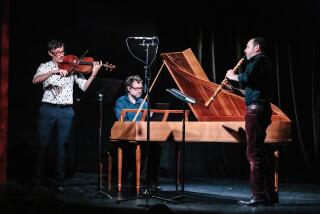THE MUSICAL DEMOCRACY OF EMERSON QUARTET
For almost a decade, the Emerson String Quartet has been playing its own version of “musical chairs.”
During that span, founding members Eugene Drucker and Philip Setzer have shared the duties of first and second violin, “split down the middle,” says Drucker. Each sits in the first chair for half of the program on any given night.
And over the years, each has had to deal with occasional raised eyebrows among chamber music buffs suspicious of any departure from the norm.
“Actually,” states Drucker, “we attracted a lot more attention in our early days than recently. Back then, some people thought it was a gimmick.
“In our early concerts, Larry (Dutton) used to announce as a joke, ‘Please note that tonight, I will play the viola and David (Finckel) will play the cello.’ ”
Drucker, who with Setzer, Dutton and Finckel appears in identical programs at Wadsworth Theater on Sunday afternoon and UC Irvine on Monday night, defends the Emersonian democracy and points out a major fringe benefit.
“In most instances,” he notes, “the first violin is more exposed in a piece, so it needs more practicing. This sharing makes it easier to divide that extra practice time.”
After more than 10 years of role-switching, Drucker still enjoys the mid-concert change of perspective. (At Wadsworth and UC Irvine, Setzer will be first violinist in Haydn’s brief Opus 103 and Ives Quartet No. 2, while Drucker will occupy the first chair for the post-intermission reading of Beethoven’s Opus 130 with the “Grosse Fuge.”)
“I find that I look around more at the others when I’m playing second,” he says. “Of course, they should all look more at me when I’m first. Also, I’m thinking more of the audience (playing second). The line has to be projected more, because the second violin is simply further from the audience. And it’s usually playing in the same range--sometimes even the same notes--as the viola.”
Would Drucker recommend the Emerson Way to young ensembles? “If it works within a group’s interpersonal chemistry, they should try it.”
The Emerson first tried it in its embryo stage at Juilliard in the mid-’70s. “Philip and I started in a student quartet,” Drucker recalls, “and at that time, it was common among such groups to share. Everyone wanted to play the juicy first violin parts. But they also needed experience in learning how to project the second violin.
“There never came a point where Philip and I said, ‘Hey, we’re a professional quartet now. Let’s get down to work.’ It (the sharing) was never a great idealistic thing. It just always worked well for us.”
But, evidently, not for others. The New York-based group (resident quartet at the Chamber Music Society of Lincoln Center) remains virtually the only major ensemble trading first and second chairs. Drucker has a possible explanation.
“There is such a thing as a first-violin personality. Look at Mann (Robert Mann of the Juilliard Quartet) and Steinhardt (Arnold Steinhardt of the Guarneri). They are more flamboyant than their second violinists, so it makes sense that they play first violin.”
Such flamboyance, says Drucker, has never been a part of the Emerson, but “we don’t want a phlegmatic first violinist. I think it’s more dangerous than among any of the other players.
“A quartet is really a contradiction in terms. We all know it’s supposed to be four equal voices. There’s no reason why the first violin (in performance) should be so attention-getting--but it sometimes works out that way. That’s all changing, though. Nowadays in a lot of quartets, all the members try to play their parts with equal conviction.”
This first-chair-as-star syndrome is a venerable one. For decades, he notes, “the first violinist in a quartet was famous.”
The most obvious example in recent times is Jascha Heifetz, who with cellist Gregor Piatigorsky, made numerous chamber appearances and recordings in the mid-’60s.
Sniffs Drucker, “It’s proper that the Heifetz/Piatigorsky concerts originated in Hollywood.”
More to Read
The biggest entertainment stories
Get our big stories about Hollywood, film, television, music, arts, culture and more right in your inbox as soon as they publish.
You may occasionally receive promotional content from the Los Angeles Times.










